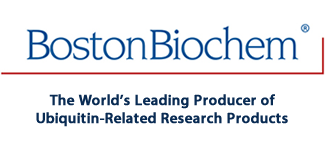
Recombinant Human NEDD8 E1 (APPBP1/UBA3) Protein, CF Summary
60 kDa (APP-BP1)
52 kDa (UBA3)
Product Datasheets
Carrier Free
CF stands for Carrier Free (CF). We typically add Bovine Serum Albumin (BSA) as a carrier protein to our recombinant proteins.Adding a carrier protein enhances protein stability, increases shelf-life, and allows the recombinant protein to be stored at a more dilute concentration.The carrier free version does not contain BSA.
In general, we advise purchasing the recombinant protein with BSA for use in cell or tissue culture, or as an ELISA standard.In contrast, the carrier free protein is recommended for applications, in which the presence of BSA could interfere.
E-313
| Formulation | Supplied as a solution in HEPES and NaCl. |
| Shipping | The product is shipped with dry ice or equivalent. Upon receipt, store it immediately at the temperature recommended below. |
| Stability & Storage: | Use a manual defrost freezer and avoid repeated freeze-thaw cycles.
|
Reconstitution Calculator
Background: NEDD8 Activating Enzyme (APPBP1/UBA3)
Neural Precursor Cell Expressed Developmentally Downregulated Gene 8 (NEDD8) Activating Enzyme (APP-BP1/UBA3) is a heterodimeric NEDD8-activating (E1) enzyme with a predicted molecular weight of 112 kDa. It is responsible for the first step in the conjugation of NEDD8 to protein substrates. The NEDD8 Activating Enzyme heterodimer is composed of a regulatory subunit, Amyloid beta Precursor Protein Binding Protein 1 (APP-BP1), and a catalytic subunit, Ubiquitin-like Modifier Activating Enzyme 3 (UBA3). Human APP-BP1 is a 534 amino acid (aa) protein with a predicted molecular weight of 60 kDa that is expressed ubiquitously in fetal tissues and in the adult brain (1). APP-BP1 is required for UBA3 neddylation activity, regulates enzyme specificity, and is expressed as two isoforms, the full length protein and a second isoform with an alternate N-terminal, aa1-17, sequence (2). APP-BP1 has been shown to drive cell cycle progression, and its expression is increased in the hippocampus of Alzheimer"s disease brains (3,4). Human UBA3 is a 463 aa protein with a predicted molecular weight of 52 kDa. It is ubiquitously expressed and shares high aa sequence identity with the C-terminal domain of human UBE1 (5). UBA3 contains an ATP-binding domain and an active site cysteine residue, Cys237 in humans, which are both common to E1 enzymes. Like APP-BP1, two isoforms of UBA3 have been identified in humans, the full length protein and a truncated isoform, which lacks aa 8-21. UBA3 is required for cell cycle progression and has been shown to downregulate steroid receptor activation (4,6). Neddylation and its associated enzymes have been implicated in the progression of Alzheimer"s disease, via neddylation of APP, and cancer via post-translational modification of oncogenes (7,8).
- Chow, N. et al. (1996) J Biol Chem 271:11339.
- Walden, H. et al. (2003) Mol Cell 12:1427.
- Chen, Y. et al. (2003) J Cell Biol 163:27.
- Chen, Y. et al. (2000) J Biol Chem 275:8929.
- Gong, L. & E.T. Yeh (1999) J Biol Chem 274:12036.
- Fan, M. et al. (2002) Mol Endocrinol 16:315.
- Chen, Y. et al. (2012) J Cell Mol Med [Epub ahead of print]
- Soucy, T.A. et al. (2010) Genes Cancer 1:708.
Citations for Recombinant Human NEDD8 E1 (APPBP1/UBA3) Protein, CF
R&D Systems personnel manually curate a database that contains references using R&D Systems products.The data collected includes not only links to publications in PubMed,but also provides information about sample types, species, and experimental conditions.
5Citations: Showing 1 - 5Filter your results:
Filter by:
- Discovery of Ubiquitin Deamidases in the Pathogenic Arsenal of Legionella pneumophilaAuthors: D Valleau, AT Quaile, H Cui, X Xu, E Evdokimova, C Chang, ME Cuff, ML Urbanus, S Houliston, CH Arrowsmith, AW Ensminger, A SavchenkoCell Rep, 2018;23(2):568-583.Applications: Bioassay
- A potent small-molecule inhibitor of the DCN1-UBC12 interaction that selectively blocks cullin 3 neddylationAuthors: H Zhou, J Lu, L Liu, D Bernard, CY Yang, E Fernandez-, K Chinnaswam, S Layton, J Stuckey, Q Yu, W Zhou, Z Pan, Y Sun, S WangNat Commun, 2017;8(1):1150.Species: HumanSample Types: Recombinant ProteinApplications: Bioassay
- SENP8 limits aberrant neddylation of NEDD8 pathway components to promote cullin-RING ubiquitin ligase functionAuthors: KE Coleman, M Békés, JR Chapman, SB Crist, MJ Jones, BM Ueberheide, TT HuangElife, 2017;6(0):.Species: HumanSample Types: Whole CellsApplications: Bioassay
- The ubiquitin-associated (UBA) domain of SCCRO/DCUN1D1 protein serves as afeedback regulator of biochemical and oncogenic activity.Authors: Huang G, Towe C, Choi L, Yonekawa Y, Bommelje C, Bains S, Rechler W, Hao B, Ramanathan Y, Singh BJ Biol Chem, 2015;290(1):296-309.
- SCCRO3 (DCUN1D3) antagonizes the neddylation and oncogenic activity of SCCRO(DCUN1D1).Authors: Huang G, Stock C, Bommelje C, Weeda V, Shah K, Bains S, Buss E, Shaha M, Rechler W, Ramanathan S, Singh B, 2014;0(0):.Species: HumanSample Types: Cell Lysates
FAQs
No product specific FAQs exist for this product, however you may
View all Proteins and Enzyme FAQsReviews for Recombinant Human NEDD8 E1 (APPBP1/UBA3) Protein, CF
There are currently no reviews for this product. Be the first toreview Recombinant Human NEDD8 E1 (APPBP1/UBA3) Protein, CF and earn rewards!
Have you used Recombinant Human NEDD8 E1 (APPBP1/UBA3) Protein, CF?
Submit a review and receive an Amazon gift card.
$25/€18/£15/$25CAN/¥75 Yuan/¥1250 Yen for a review with an image
$10/€7/£6/$10 CAD/¥70 Yuan/¥1110 Yen for a review without an image
ebiomall.com






>
>
>
>
>
>
>
>
>
>
>
>
两个基因大小分别230kb和450kb,酶切后,450kb的有目的条带,但很弱,230kb的质粒条带亮,其下方有一很微弱条带,用的酶分别是:Ncol和Spel体系是(Takara,两个酶切体系不同,用的官网推荐体系):
NcoI1μl
Spel1μl
10×KBuffer2μl
0.1%BSA2μl
DNA3ul
灭菌水upto20μl37℃4h电泳1h
根据发展历史、影响力、测序原理和技术不同等,主要有以下几种:大规模平行签名测序(Massively Parallel Signature Sequencing, MPSS)、聚合酶克隆(Polony Sequencing)、454焦磷酸测序(454 pyrosequencing)、Illumina (Solexa) sequencing、ABI SOLiD sequencing、离子半导体测序(Ion semiconductor sequencing)、DNA 纳米球测序 (DNA nanoball sequencing)等。 基因分析仪(即DNA测序仪),采用毛细管电泳技术取代传统的聚丙烯酰胺平板电泳,应用该公司专利的四色荧光染料标记的ddNTP(标记终止物法),因此通过单引物PCR测序反应,生成的PCR产物则是相差1个碱基的3'末端为4种不同荧光染料的单链DNA混合物,使得四种荧光染料的测序PCR产物可在一根毛细管内电泳,从而避免了泳道间迁移率差异的影响,大大提高了测序的精确度。由于分子大小不同,在毛细管电泳中的迁移率也不同,当其通过毛细管读数窗口段时,激光检测器窗口中的CCD(charge-coupled device)摄影机检测器就可对荧光分子逐个进行检测,激发的荧光经光栅分光,以区分代表不同碱基信息的不同颜色的荧光,并在CCD摄影机上同步成像,分析软件可自动将不同荧光转变为DNA序列,从而达到DNA测序的目的。分析结果能以凝胶电泳图谱、荧光吸收峰图或碱基排列顺序等多种形式输出。
利用NheI和HindIII双酶切插入目的片段,为什么双酶切有目的片段和切开的质粒,测序却没有?
并且测序后在NheI位点后的序列变成了-GGCTAGGTAC-Kpn位点(CGTTTAAACTTAAGCTTG消失。之前和之后的序列都相符),之间的怎么都没了?
2.SNaPshot法 该技术由美国应用生物公司(ABI)开发,是基于荧光标记单碱基延伸原理的分型技术,也称小测序,主要针对中等通量的SNP分型项目。在一个含有测序酶、四种荧光标记ddNTP、紧临多态位点5’-端的不同长度延伸引物和PCR产物模板的反应体系中,引物延伸一个碱基即终止,经ABI测序仪检测后,根据峰的移动位置确定该延伸产物对应的SNP位点,根据峰的颜色可得知掺入的碱基种类,从而确定该样本的基因型。对于PCR产物模板可通过多重PCR反应体系来获得。通常用于10-30个SNP位点分析。
3.HRM法 高分辨率熔解曲线分析(HRM)是近几年兴起的SNP研究工具,它通过实时监测升温过程中双链DNA荧光染料与PCR扩增产物的结合情况,来判断是否存在SNP,而且不同SNP位点、是否是杂合子等都会影响熔解曲线的峰形,因此HRM分析能够有效区分不同SNP位点与不同基因型。这种检测方法不受突变碱基位点与类型的局限,无需序列特异性探针,在PCR结束后直接运行高分辨率熔解,即可完成对样品基因型的分析。该方法无需设计探针,操作简便、快速,成本低,结果准确,并且实现了真正的闭管操作。
4.Mass Array法 MassARRAY分子量阵列技术是Sequenom公司推出的世界上领先的基因分析工具,通过引物延伸或切割反应与灵敏、可靠的MALDI-TOF-MS技术相结合,实现基因分型检测。基于MassARRAY平台的iPLEX GOLD技术可以设计最高达40重的PCR反应和基因型检测,实验设计灵活,分型结果准确性高。根据应用需要,对数十到数百个SNP位点进行数百至数千份样本检测时,MassARRAY具有最佳的性价比,特别适合于对全基因组研究发现的结果进行验证,或者是有限数量的研究位点已经确定的情况。
5.Illumina BeadXpress法 采用Illumina公司的BeadXpress系统进行批量SNP位点检测,可以同时检测1-384个SNP位点,往往用于基因组芯片结果确认,适合高通量检测。微珠芯片具有高密度、高重复性、高灵敏度、低上样量、定制灵活等特点,极高的集成密度,从而获得极高的检测筛选速度,在高通量筛选时可显著降低成本。向左转|向右转
请教高人,这样的问题怎么解决?
多谢
用takara的in-fusion方法做了个重组质粒,如左图PCR验证,右起第二道是空载质粒为模板的对照。右图是酶切验证,两个图片结合起来觉得除了第四个单克隆外,其他几个应该都可能是阳性克隆。结果送了1,2两个样品后测序的结果都不对。为什么会这样。
2.SNaPshot 该技术由美应用物公司(ABI)发基于荧光标记单碱基延伸原理型技术称测序主要针等通量SNP型项目含测序酶、四种荧光标记ddNTP、紧临态位点5’-端同度延伸引物PCR产物模板反应体系引物延伸碱基即终止经ABI测序仪检测根据峰移位置确定该延伸产物应SNP位点根据峰颜色知掺入碱基种类确定该本基型于PCR产物模板通重PCR反应体系获通用于10-30SNP位点析
期待着高手们的指点,谢谢。
以这些标准看,目前的基因组测序结果,还没有一个是完美的。
人类基因组:缺点在哪里?
首先,人类基因组还不够精确。人是“二倍体”,也就是有一半遗传物质来自父亲,一半遗传物质来自母亲,且在受精卵形成过程中,还会发生基因重组,这是人类遗传多样性的来源之一。科学家们需要更精确的“单倍型”数据,这样基因组才够“完美”,而这种“完美”正是研究者们追求的目标。
其次,人类基因组还不够多元。
按照传统的人种分类,人类按照肤色黑白黄棕,被粗分为四大类:尼格罗人种、高加索人种、蒙古人种、澳大利亚人种。基因组测序数据是从高加索人种开始的,人类基因组计划是人类的标准参考基因组,也是高加索人种的标准参考基因组。文特尔的基因组,测序对象是他自己,同样是高加索人种。
然而,从基因组研究的角度,为了尽可能地包括各种遗传背景,需要为更多族裔建立自己的参考基因组。
资料来源:http://www.mv163.cn/jkgl/news/2015/1224/5227.html
2.SNaPshot法 该技术由美国应用生物公司(ABI)开发,是基于荧光标记单碱基延伸原理的分型技术,也称小测序,主要针对中等通量的SNP分型项目。在一个含有测序酶、四种荧光标记ddNTP、紧临多态位点5’-端的不同长度延伸引物和PCR产物模板的反应体系中,引物延伸一个碱基即终止,经ABI测序仪检测后,根据峰的移动位置确定该延伸产物对应的SNP位点,根据峰的颜色可得知掺入的碱基种类,从而确定该样本的基因型。对于PCR产物模板可通过多重PCR反应体系来获得。通常用于10-30个SNP位点分析。









